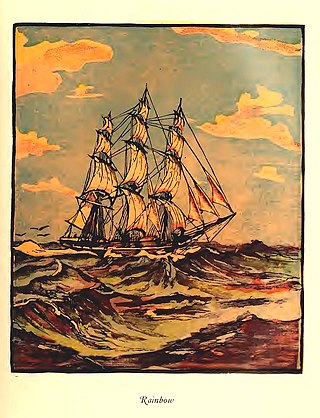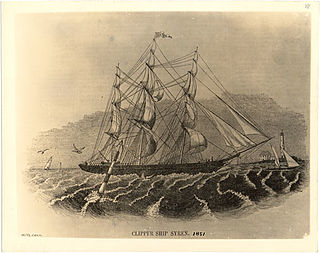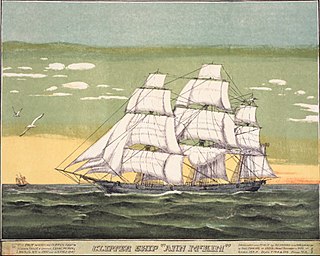Related Research Articles

A clipper was a type of mid-19th-century merchant sailing vessel, designed for speed. Clippers were generally narrow for their length, small by later 19th-century standards, could carry limited bulk freight, and had a large total sail area. "Clipper" does not refer to a specific sailplan; clippers may be schooners, brigs, brigantines, etc., as well as full-rigged ships. Clippers were mostly constructed in British and American shipyards, although France, Brazil, the Netherlands, and other nations also produced some. Clippers sailed all over the world, primarily on the trade routes between the United Kingdom and China, in transatlantic trade, and on the New York-to-San Francisco route around Cape Horn during the California Gold Rush. Dutch clippers were built beginning in the 1850s for the tea trade and passenger service to Java.

Flying Cloud was a clipper ship that set the world's sailing record for the fastest passage between New York and San Francisco, 89 days 8 hours. The ship held this record for over 130 years, from 1854 to 1989.

Donald McKay was a Canadian-born American designer and builder of sailing ships, famed for his record-setting extreme clippers.

Champion of the Seas was the second largest clipper ship destined for the Liverpool, England - Melbourne, Australia passenger service. Champion was ordered by James Baines of the Black Ball Line from Donald McKay. She was launched 19 April 1854 and was abandoned 3 January 1877, off Cape Horn.

Marco Polo was a three-masted wooden clipper ship, launched in 1851 at Saint John, New Brunswick. She was named after Venetian traveler Marco Polo. The ship carried emigrants and passengers to Australia and was the first vessel to make the round trip from Liverpool in under six months. Later in her career, the ship was used as a cargo ship before running aground off Cavendish, Prince Edward Island, in 1883.

James Baines was a passenger clipper ship completely constructed of timber in the 1850s and launched on 25 July 1854 from the East Boston shipyard of the famous ship builder Donald McKay in the United States for the Black Ball Line of James Baines & Co., Liverpool. The clipper was one of the few known larger sailing ships rigged with a moonsail.

Stag Hound was launched on December 7, 1850 in East Boston, Massachusetts. Designed by shipbuilder Donald McKay for the California trade, she was briefly the largest merchant ship in the world. She was in active service from 1851 until her total loss in 1861.

Rainbow, launched in New York in 1845 to sail in the China trade for the firm Howland & Aspinwall, was a clipper, a type of sailing vessel designed to sacrifice cargo capacity for speed.

Surprise was a California clipper built in East Boston in 1850. It initially rounded Cape Horn to California, but the vessel's owners, A. A. Low & Brother, soon found that the vessel performed well in Far Eastern waters. From that point onward the vessel spent much of her working life in the China trade, although the vessel also made three trips from the East Coast of the United States to California.

Herald of the Morning was one of the few clipper ships with a passage to San Francisco in less than 100 days.
Antelope was a medium clipper built in 1851 in Medford, near Boston, Massachusetts. She sailed in the San Francisco, China, and Far East trades, and was known for her fine finish work and for her crew's escape from pirates. She is often called Antelope of Boston to distinguish her from the extreme clipper Antelope of New York launched in 1852.

James Otis Curtis was an American shipbuilder who built ships in Medford, Massachusetts. He built wooden ships that were either powered by sail or by screw and steam.
Paul Curtis was an American shipbuilder who built ships in Medford, Massachusetts.
A medium clipper is a type of clipper designed for both cargo carrying capacity and speed. An evolutionary adaptation of the extreme clipper, the medium clipper had been invented by 1851, when the hull type appeared in U.S. shipyards. Medium clippers continued to be built until 1873, when Pilgrim, one of the last known medium clipper ships to be built, was launched by Joshua T. Foster from the shipyards of Medford, Massachusetts.

Syren was the longest lived of all the clipper ships, with a sailing life of 68 years 7 months. She sailed in the San Francisco trade, in the Far East, and transported whaling products from Hawaii and the Arctic to New Bedford.

Shooting Star was an extreme clipper built in 1851 near Boston, in Medford, Massachusetts. She was the first "real clipper" to be built in Medford, and sailed in the San Francisco, China, and Far East trades. According to Howe and Matthews, she was known as "one of the fastest of the small clippers".

Ann McKim was one of the early true clipper ships, designed to meet the increasing demand for faster cargo transportation between the United States and China in the early 1840s. The opening of new Treaty ports in the East allowed American merchants greater access to trade with China, leading to the need for ships that could move cargo more quickly than traditional merchant ships. Ann McKim was one of the ships that had answered the demand in the early years and sailed between New York and China in 1840–1842, until newer and faster cargo-carriers, such as the nearly 600-ton clipper Houqua, the 598-ton China packet Helena, Witch of theWave, and Rainbow started dominating the shipping world of the US-China trade and Ann McKim was shifted back to the South American trade routes.

Hurricane was a large extreme clipper of 1608 tons burthen built in Hoboken, New Jersey, United States in 1851. Reputedly the most extreme clipper ever built, Hurricane proved a very fast vessel, reportedly capable of speeds of up to 18 knots (33 km/h) in ideal conditions, and establishing a number of record passages in the early years of her career.

Scottish Maid was a Scottish packet boat, a two-masted wooden schooner, built at Alexander Hall and Sons' boatyard in 1839 for the Aberdeen Line. She has been described as the first clipper vessel to be built in Britain. Her design of sharp, forward-raked bow, later called the "clipper bow" or Aberdeen bow, pioneered a succession of larger clipper ships with many also built in Aberdeen on Scotland's northeast coast.
References
- 1 2 Clark, Arthur H. (1910). The Clipper Ship Era, An Epitome of Famous American and British Clipper Ships, Their Owners, Builders, Commanders, and Crews, 1843–1869. Camden, ME: G.P. Putnam’s Sons.
- ↑ MacGregor, David R (1988). Fast Sailing Ships, their design and construction, 1775-1875 (Second ed.). London: Conway Maritime Press. ISBN 0-87021895-6.
- ↑ Clark, The Clipper Ship Era, pp. 65–66.
- ↑ McDowell, Carl E.; Gibbs, Helen M. (1999). Ocean Transportation. Beard Books. p. 22. ISBN 978-1-893122-45-1.
- ↑ "Medford-Built Sailing Ships". 22 February 2013.
- ↑ Boston Daily Atlas, November 29, 1851
- ↑ The Boston Daily Atlas, August 4, 1852
- ↑ "Clipper ships", Stoddart's Encyclopaedia Americana; a dictionary of arts, sciences, and general literature, and companion to the Encyclopædia Britannica. American Supplement., vol. 2 (9th ed.), New York, Philadelphia: J.M. Stoddart, 1884, p. 151
- ↑ Boston Daily Atlas, July 29, 1852
- ↑ Boston Daily Atlas, March 6, 1851
- 1 2 Boston Daily Atlas, December 29, 1852